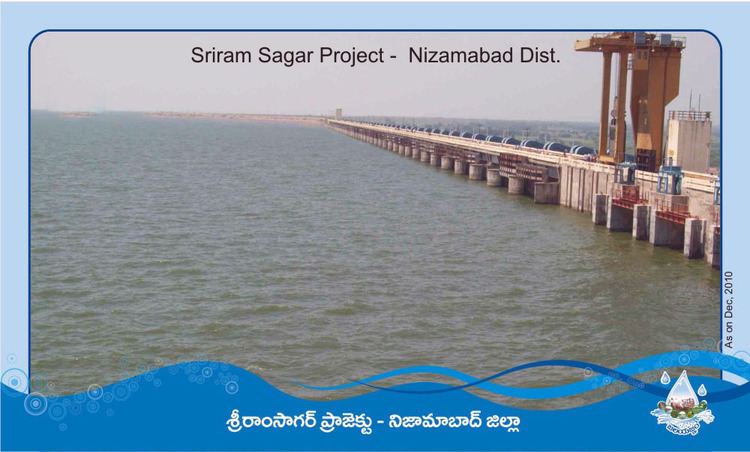Opening date 1977 Construction began 1963 | Impound Godavari River | |
 | ||
Height 43 metres (141 ft) from river level Length 15,600 metres (51,181 ft) Total capacity 3,172,000,000 m (2,571,582 acre·ft) Similar Nizam Sagar, Godavari River, Jurala Project, Srisailam Dam, Nagarjuna Sagar Dam | ||
Special story on sriram sagar project nizamabad reporters dairy v6 news
The Sri Rama Sagar Project (Telugu: శ్రీరాంసాగర్ ప్రాజెక్టు), also known as the Pochampadu Project is an Indian flood-flow project on the Godavari River. The Project is located in Nizamabad district, 3 km away from National Highway 44. It has been described by The Hindu as a "lifeline for a large part of Telangana".
Contents
- Special story on sriram sagar project nizamabad reporters dairy v6 news
- Map of Sriram Sagar Project Telangana
- History
- The project
- Interstate dispute
- References
Map of Sriram Sagar Project, Telangana
Sriramsagar is an irrigation project across river Godavari in Telangana to serve irrigational needs in Karimnagar, Warangal, Adilabad, Nalgonda, and Khammam districts. It also provides drinking water to Warangal city. There is a hydroelectric plant working at the dam site, with 4 turbines each with 9 MW capacity generating 36 MW.
History
The foundation was laid on 26 July 1963 by the late Jawaharlal Nehru, first Prime Minister of India.
The project
Sriram Sagar Reservoir's capacity is 75 tmcft and it has 42 floodgates. It also includes Kakatiya Canal covering 284 km, Laxmi Canal, Sarswati Canal, and Flood flow canal. Construction of this dam was started in 1957. Most of the catchment area upstream of this dam is located in Maharashtra.
This project is also locally known as Khustapuram dam. The Khustapuram project proposal was first mooted/investigated by erstwhile Hyderabad state under Nizam rule to utilize 227 tmcft of upper Godavari river water. This dam site is located in the Nizamabad district of Telangana State after the confluence of Manjira river with Godavari. Under stage I of this project nearly 1 million acres (4,000 km2) irrigation facility is created to utilize 140 tmc water. Stage II of this project is under advanced stage of construction to irrigate 440,000 acres (1,800 km2) using 25 tmc water. The flood flow canal project is also under implementation to irrigate 200,000 acres (810 km2) using 20 tmcft water available at Pochampadu dam site. The live storage capacity of SS dam is limited to 90 tmcft to reduce submergence area in Maharashtra up to FRL level 1,091 feet (333 m) above mean sea level as per the agreement between Maharashtra & Telangana.
Interstate dispute
In the catchment area of this dam, Maharashtra has constructed many medium and minor irrigation projects in excess of its water use entitlements under Godavari Water Disputes Tribunal ( GWDT ). In last nine years, the dependable water availability has reduced to 33% (i.e. adequate water is available once in three years) against the designed dependability of 75% under GWDT. This major irrigation project has become many years unproductive / idle in the last decade. Due to complete utilization of river water in the upstream river basin area, the water quality in the reservoir has high alkalinity and salinity which is unsafe for human and cattle consumption. Also the ground water in the lower reaches of Pochampadu dam catchment area would gradually turn unsuitable for irrigation and human consumption.
Supreme court verdict (section 83 ii b) on Babli Project dispute stipulated that the gates of Babhali barrage remain lifted during the monsoon season, i.e., July 1 to October 28 and there is no obstruction to the natural flow of Godavari river during monsoon season below the three dams (Paithan, Siddheshwar & Nizamsagar dams) mentioned in Clause II (i) of the GWDT agreement dated 06.10.1975 towards Pochampad dam. Thus Pochampadu reservoir is accorded first priority over any other reservoir (major, medium, minor, barrage, etc.) to receive the water generated from the Godavari basin area located below these three dams. As stipulated by Supreme court, central government has set up monitoring committee to implement / supervise the water sharing as per agreement dated 06.10.1975 and supreme court verdict.
